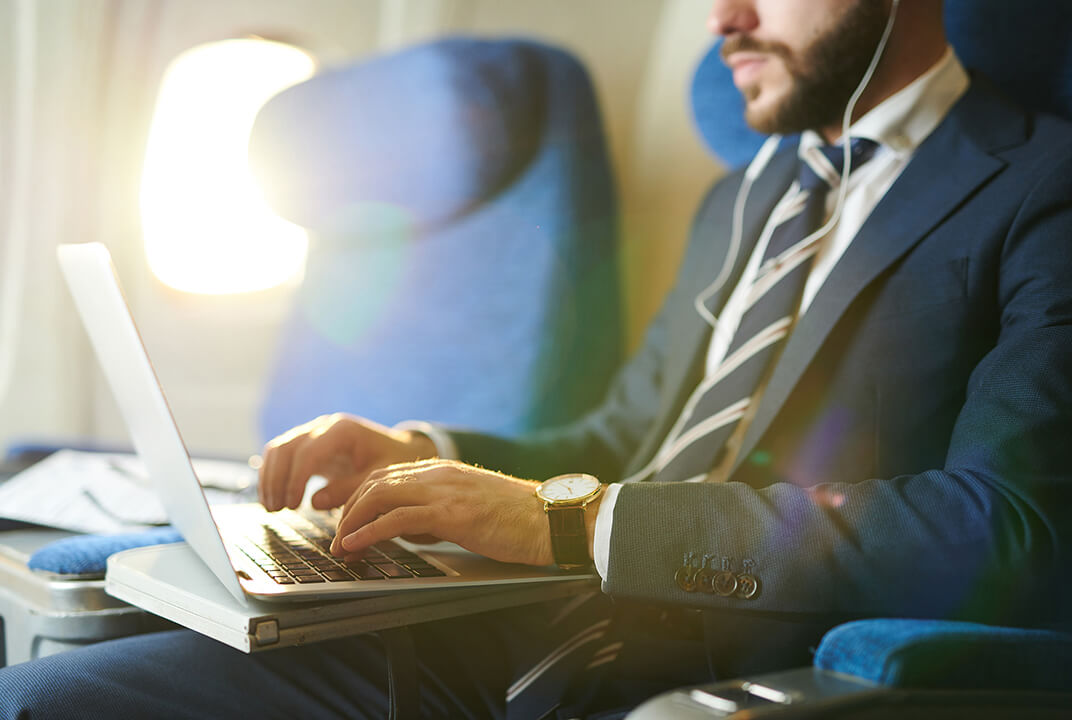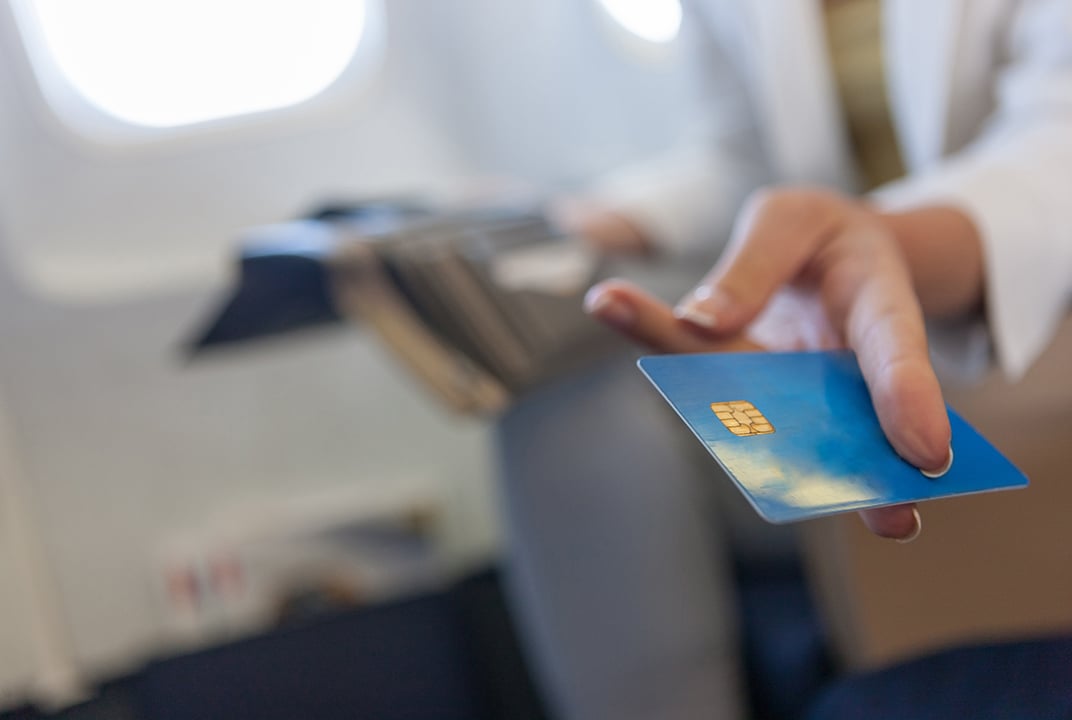Insight | The future passenger experience
The future passenger experience
Aviation
Better tech, faster speeds, new revenue streams
The connectivity revolution is gathering pace. As we know, some airlines already have inflight broadband – and penetration is greatest in the US. But the offerings vary enormously by carrier and the quality is often less than stellar. Inflight Wi-Fi can be slow, patchy and expensive. This is down to the technology which is currently used – it’s often not up to the job of maintaining dozens of connections on a plane travelling at 560mph.
However, this is changing, fast. The next few years are going to see inflight broadband appear where it doesn’t exist and get much better where it does.
Public appetite for this is not in doubt. People are used to being able to access services like Facebook, Netflix and Amazon wherever they are. According to the 2017 Inmarsat survey of 9,000 fliers, 83% of passengers would choose an airline that offered inflight Wi-Fi over a similar carrier that didn’t. In 2018, this demand remains strong with passengers looking to rebook airlines that offer inflight Wi-Fi. What’s more, if airlines turn these stats into actions, some additional research – in the form of a ground-breaking new study by the London School of Economics (LSE) – found that airlines could experience $15.9bn in incremental revenues, by 2035, through charging passengers for inflight broadband access.
Several airlines and aircraft manufacturers have already mobilised. On its website, Airbus says it “delivers the full breadth of new connectivity services and is a generation beyond any other available system.”
Similarly, some carriers – such as Lufthansa and Singapore Airlines – have sophisticated inflight offerings. And others, such as Qatar Airways and Emirates, intend to adopt a high-speed broadband service (provided through Inmarsat’s GX Aviation service) soon. Increasingly, airlines are recognising the importance of providing connectivity.
“There are perhaps three types of airline,” explains Dr Alexander Grous, the LSE academic who authored the ancillary revenue report.
“One type of airline is sophisticated and already trialling inflight connectivity, testing the market – they are a minority. The next is the majority – they want to play in this space, they think they know what to do but they need guidance. The third airline admits they have no idea – they can only supply connectivity in the cockpit.”
Disruptive devices
If better technology is one half of this equation, the rise of the smartphone is the other. The first iPhone appeared in 2007 and now, ten years later, smartphones are ubiquitous. A 2017 Pew Research study showed that Sweden has 72.2% smartphone penetration, while the US has 69.3% and the UK 68.6%. The United Arab Emirates is the champion with an astonishing 80.6%.
Smartphones have been a genuinely disruptive technology and have made mobile internet a mass market phenomenon. They have been the single biggest driver behind ordinary consumers expecting internet access everywhere. Demand for mobile data has increased dramatically – 18-fold in the five years from 2011, and it’s forecast to represent 20% of all internet traffic by 2021. The LSE study revealed that 65% of travelers book hotels with mobile devices for same-day stays and 40% make entertainment bookings online. It’s no surprise there is demand for high-speed broadband in the air, too.
It’s possible that, as the market develops and passengers become used to the availability of inflight connected services, their behaviours will change. For example, delaying a car hire booking until they are inflight, to get the best last-minute deal. But it’s not just about what passengers want. Better inflight broadband delivers considerable upsides for airlines, too.
The first benefit is obvious. If you offer people quality inflight broadband, you can charge for it. In an industry where there have been decades of downward pressure on ticket prices, this offers a new revenue stream and an opportunity to build per passenger-mile revenue, especially with low-margin economy fliers. Yet only 25% of commercial aircraft today currently offer inflight connectivity of any kind – airlines haven’t yet capitalised on the true financial potential for the 3.8bn passengers who fly each year.
High-quality inflight broadband could also be the difference between a potential passenger choosing airline A over airline B. Offering people more to do on board – whether it’s social media or live sport – is likely to translate into greater customer satisfaction and, thus, greater loyalty.
A captive market
Passengers represent a highly captive audience – remaining on board, interacting with an airline, for up to 14 hours – which is an advertiser’s dream. Connectivity means advertising can be highly-targeted because an airline knows its passengers and who is in which class. And then there’s sponsorship: watch this ad and get ten minutes’ online for free. The airline passenger audience could offer a higher level of engagement than on the ground, and the forecast (taken from the LSE report) is that overall advertising revenue could reach $6.1bn by 2035.
Of course, airlines may know which passenger is sitting in which class already but, in offering high-speed, inflight broadband, huge volumes of additional data can be generated. And with this data comes the opportunity to highly personalise the passenger experience. But only 11% of existing airline schemes offer personalised rewards based on purchase history or location data, despite evidence that the average order value for personalised transactions is 12% higher than those without.
As the New York Times recently put it, “on an airplane you have a captive market, and with sophisticated technology you can sell to passengers in very personal ways”.
There are some carriers delving into this space already. British Airways uses a ‘Know Me’ feature to allow in-depth data analysis by customer in order to deliver personalised offers. United uses a smart ‘collect, detect, act’ system that employs artificial intelligence to analyse 150 variables in a customer profile in 200 milliseconds. It will then determine a flyer’s likely preferences, enabling United to tailor-make ancillary offers. The system has reportedly increased revenues by over 15% annually.
"On an airplane you have a captive market, and with sophisticated technology you can sell to passengers in very personal ways"
A revenue revolution
There’s the possibility of other ancillary revenue streams too. There’ll be greater opportunities for inflight shopping. Retail Week recently calculated that the potential extra inflight spending based on terrestrial online shopping habits is as much as $2.47bn. Improved broadband could mean everything from a better range of goods, to real-time card transactions, to stronger affiliate programmes with third parties. It means airlines can go from selling very limited ranges of things to selling, well, anything. Onward travel tickets, destination-focused activities, car hire, larger items delivered to the home – even stock personalised to the passengers on board. The ageing duty-free trolley will be left behind.
There’s also live sport, for which there is already a strong and proven demand (and which airlines like Lufthansa already offer). Other possibilities in this vein include a hugely-increased choice of video on demand and new deals between airlines and content distributors.
Looking further ahead, the possibilities are the same as those offered by the meeting of super-fast home broadband and other technologies. Using VR headsets, passengers could spend flights in fully immersive multiplayer games. Or they could chat to friends or relatives, but sitting side by side in a virtual space that looks like, say, a mountain cafe in Switzerland. They could have their driverless car pick them up from the airport and take them home where an automated grocery or meal delivery, booked mid-flight, is timed to coincide with their arrival.
There may also be significant cost savings from BYOD (bring your own device). If all passengers have at least one small screen with them, is there any need to put screens in the seats? Many budget airlines already do without seatback screens, and the financial rationale for removing screens is compelling. Airline regulations mean that the average seat-back screen costs $10,000 – and can add around six kilos in weight per seat which lowers fuel economy. The tech world moves so quickly, too, that seatback sets look and feel dated long before they are due for an upgrade.
For business users, the case is equally strong. Flying time is still viewed by many as dead time. But with high-speed, reliable broadband, it will be possible for passengers to participate in meetings and even use videoconferencing while they’re in the air. They’ll be able to work in the Cloud as they do on the ground and, as services improve, work with others in virtual spaces. Research carried out by Egencia, Expedia’s business travel arm, revealed 49% of business travellers surveyed said that inflight Wi-Fi increases their productivity, even though only 29% are reimbursed for it.
In some ways, airlines are catching up with the rest of the world. Today, there are few places on Earth where you can’t get online. But air travel is the final frontier for widespread, fast broadband. And with recent research from Inmarsat’s global Passenger Survey suggesting that inflight Wi-Fi is ‘no longer a luxury, but a necessity’, it’s clear that now is the time to join the connectivity revolution.


